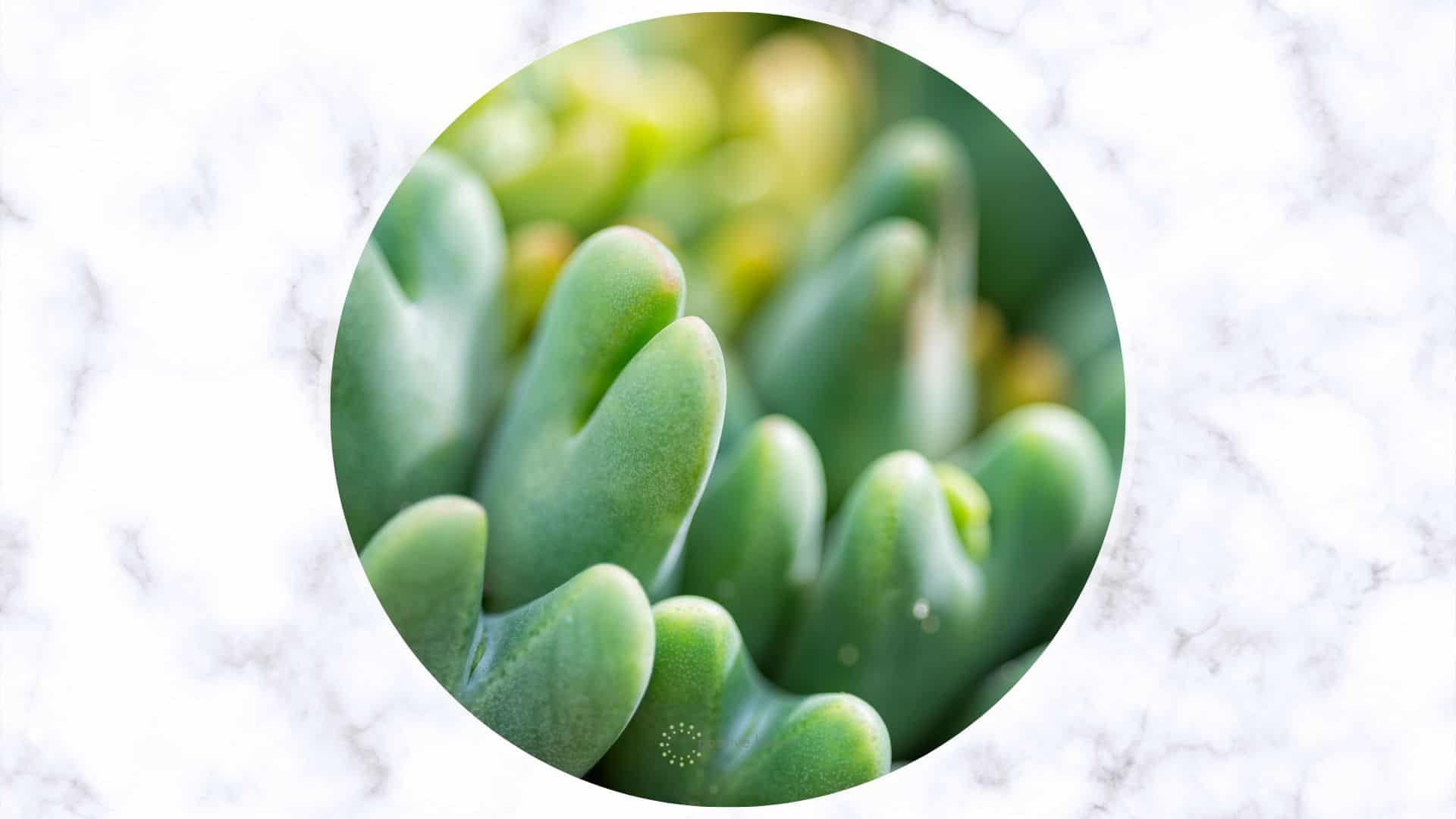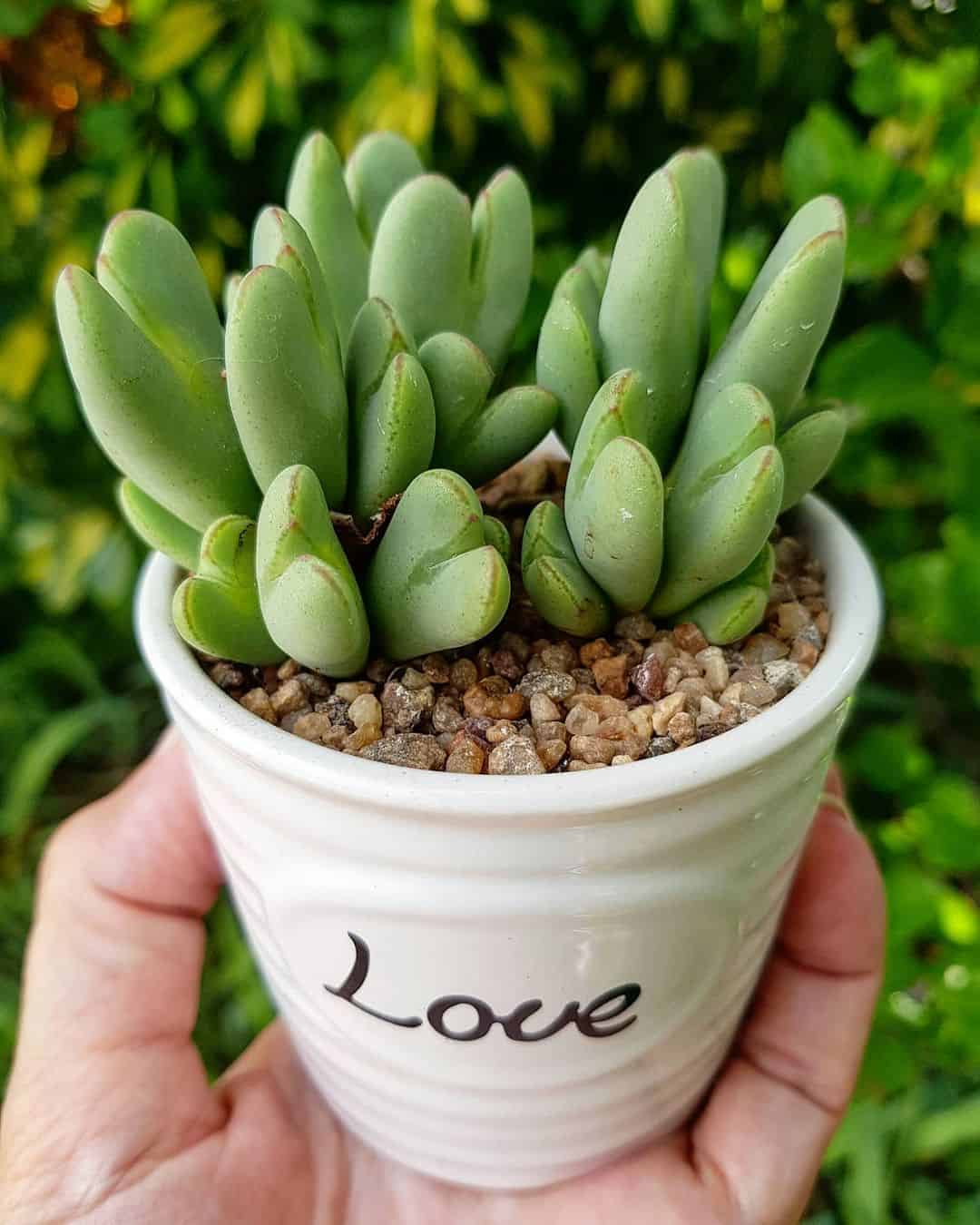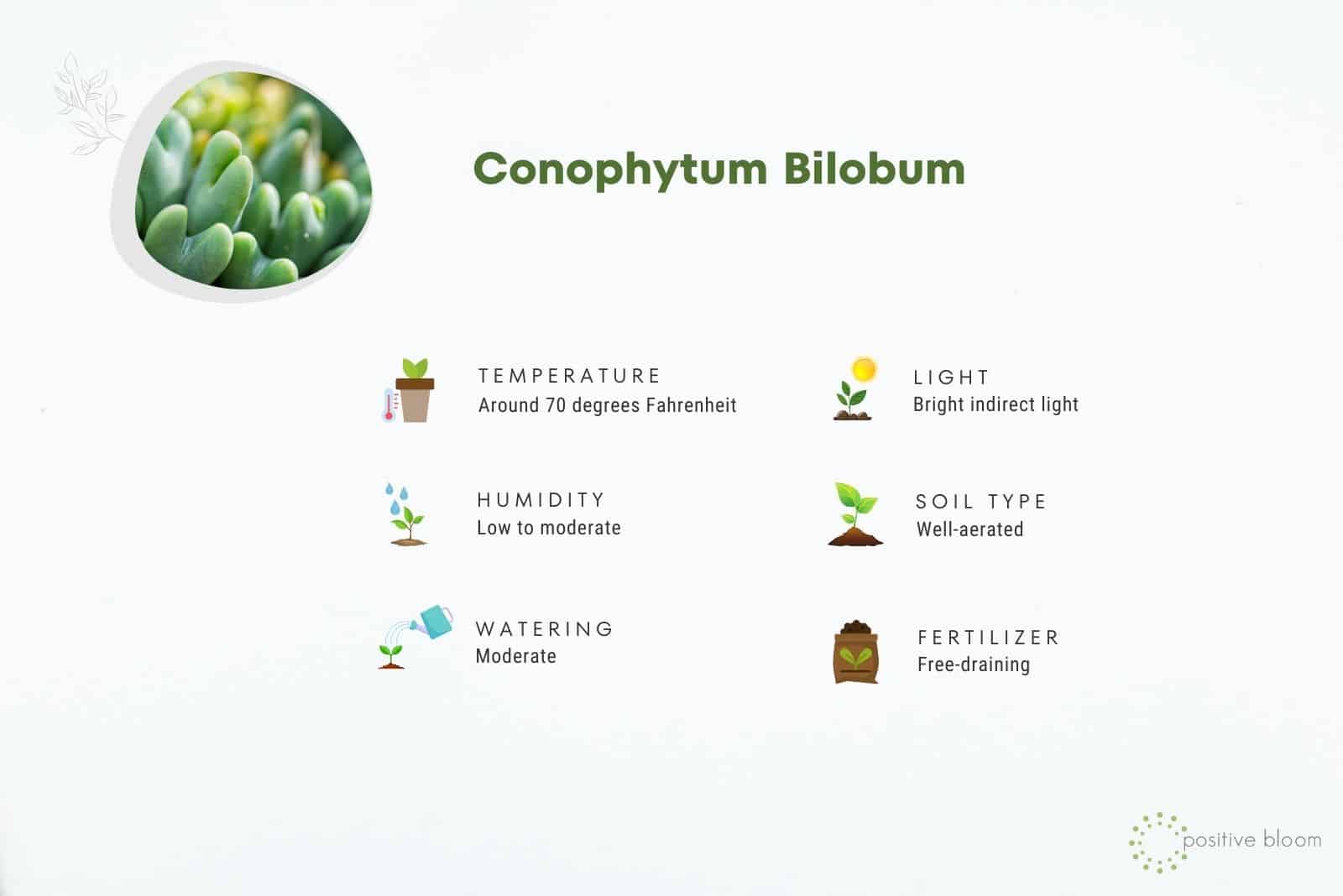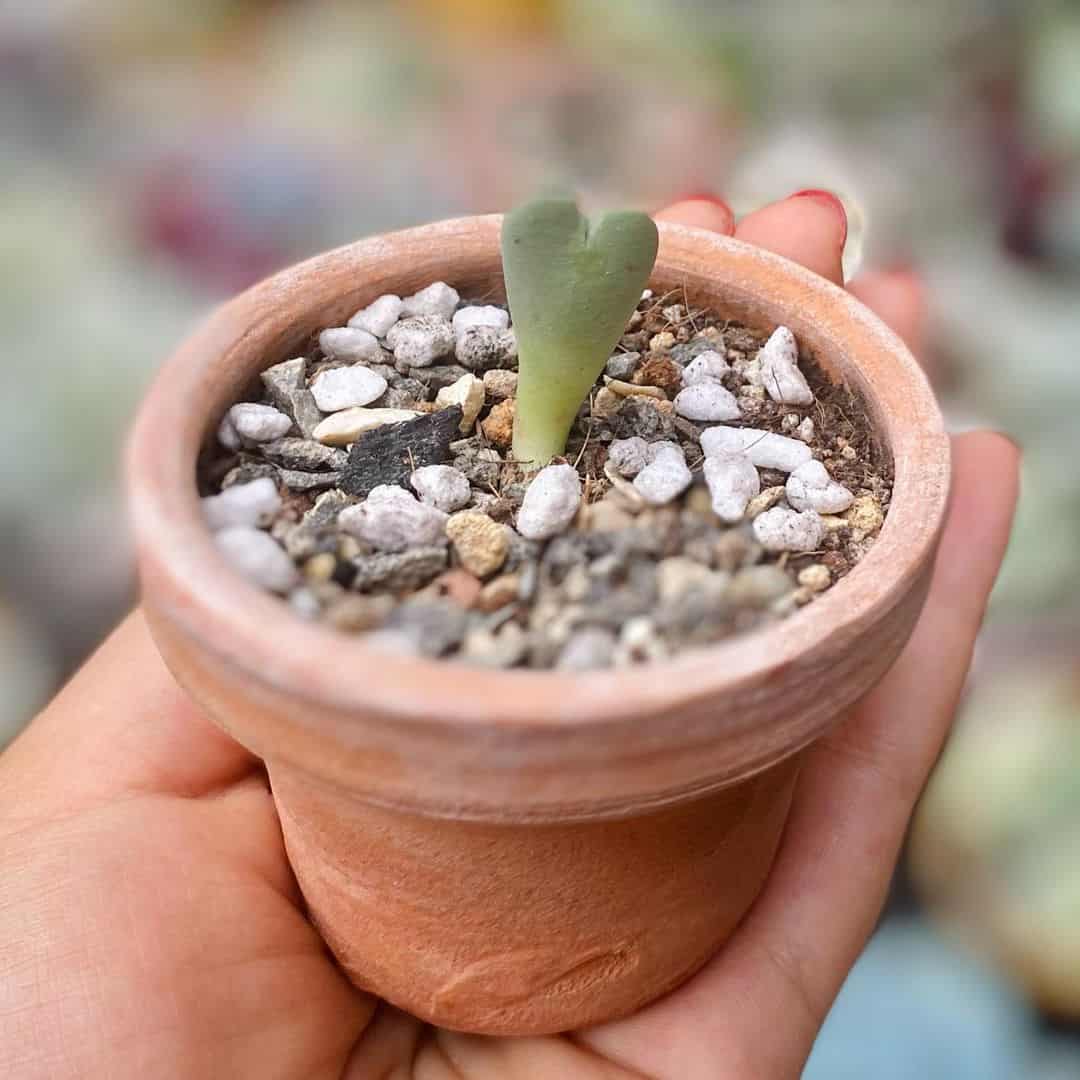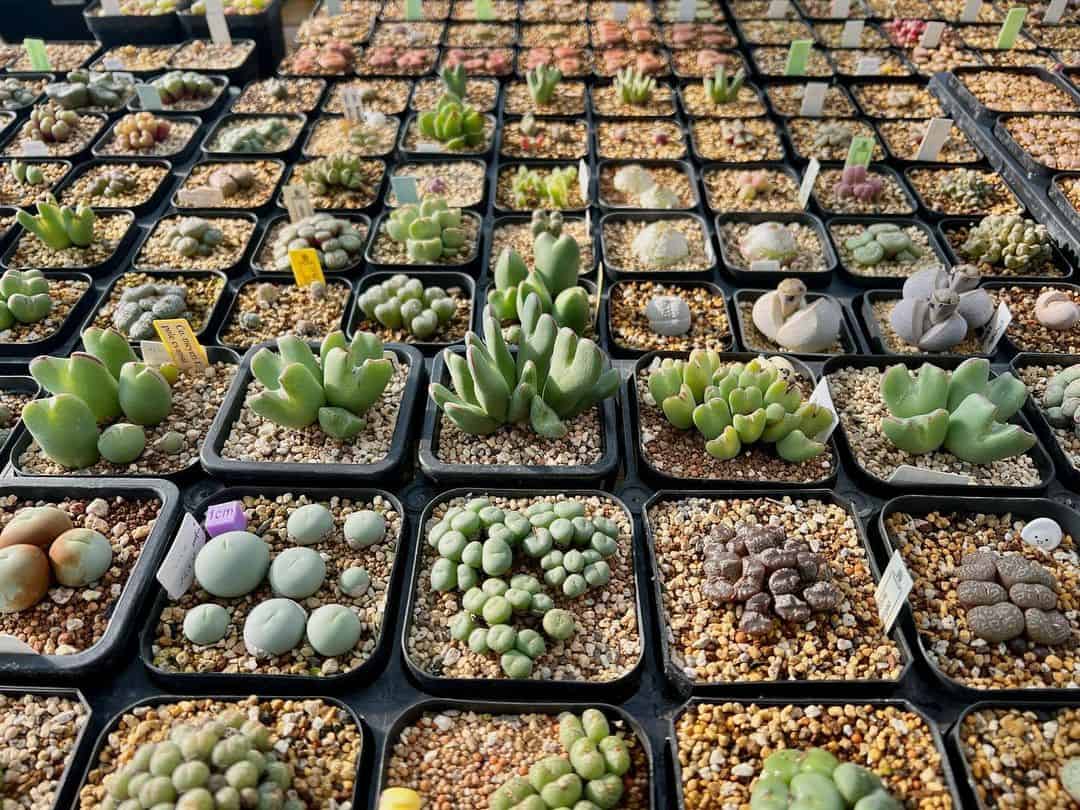Succulent plants make a great addition to any room and are perfect for gardening newbies.
Choosing new plants for our collections is sometimes very challenging, so let me help you out.
In this article, I’ll tell you more about a lovely succulent plant; meet the Lively pebble, scientifically known as the Conophytum bilobum.
Its unique appearance and growth habit make this short-stemmed succulent perfect for indoor and outdoor cultivation.
[table id=633 /]
Let’s get started!
What is The Conophytum Bilobum?
There’s one tricky thing about this species; it comes under many synonyms, making its taxonomic background pretty hard to understand.
If you come upon any of the names from the list below, you need to know that they all refer to the same plant – the Conophytum bilobum.
• Mesembryanthemum bilobum
• Conophytum meyerae
• Conophytum elishae
• Mesembryanthemum elishae
• Conophytum conradii
This plant belongs to the Aizoaceae family, just like Lithops, Delospermas, Glottiphyllums, and Mesembryanthemum species (Heart leaf ice plant).
The species got the name “bilobum” as its body consists of two lobes.
The Living pebble plant is a succulent, which means the leaves are fleshy. The foliage comes in yellowish-green, brownish-pink, or deep blue-green. The surface of the leaves is typically smooth, but it can be slightly rough, so that shouldn’t worry you.
The leaf edges can be green to reddish or sometimes even deep purple.
The Living pebble plant produces lovely diurnal, scentless blossoms and it’s one of the succulent species with yellow flowers.
You can also find some subspecies, such as the Conophytum Bilobum subsp. gracilistylum N. E. Br., that produce pink blossoms.
Living pebble plants are either stemless or produce short stems.
How To Care For The Conophytum Bilobum
Just like other succulent specimens, the bilobum plant thrives on a bit of neglect. Let’s look at the perfect growing conditions for this magnificent plant!
Light Requirements
These plants typically need a lot of daytime exposure to bright sunlight. However, Conophytum plants don’t respond well to direct sunlight, and if it’s combined with high temperatures, it can result in severe sunburns.
What you can do is expose your bilobum plant to direct sun in the morning, then move it away from the full sun once the afternoon approaches.
Be careful with light levels, as insufficient lighting leads to etiolation in succulent plants.
Watering Schedule
One of the things that makes the Conophytum special is summer dormancy. Unlike other common indoor plants, your bilobum will sleep during summer and display new growth at the beginning of the fall.
Bilobum plants need little water, especially during hibernation. Many growers claim their bilobum plants do well if not watered during summer at all.
To avoid any potential problems, irrigate your Living pebble once a month during summer dormancy. During the growing season, wait until the growing medium dries out before adding water.
If you irrigate your bilobum too frequently, you’ll notice unsightly scars on the foliage. Remember that overwatering is most often the reason why your succulent is dying.
Humidity & Temperature Requirements
These plants perform best if grown in low to moderate humidity. If the humidity in your household is higher than average, place your bilobum in a room with very good ventilation.
Conophythum plants grow best in rooms with temperatures of around 70 degrees Fahrenheit.
These plants can be cultivated outdoors, but only in USDA zones 10b through 11b.
Conophytum species aren’t resistant to cold. Anything lower than 35 degrees Fahrenheit can quickly kill this plant, so if you grow your bilobum outdoors, take it back in when temperatures drop.
Soil Mix
You’ll need to ensure porous and well-drained soil for your bilobum plant to thrive. Good drainage is essential for avoiding fungal diseases such as root rot.
Luckily, all plant stores sell soil blends made specifically for succulent and cacti plants.
If you want to make your own growing substrate, I recommend mixing loam, gravel, and sand.
Pot holes will allow excess water to drain from the growing substrate, so go with pots with plenty of holes in the bottom.
Fertilizing Schedule
Believe it or not, you can do more harm than good by feeding Conophytum plants. If you repot your bilobum once every 2 years, there’s no need to feed it.
If you want to give your bilobum a nutrient boost, apply fertilizers for succulents diluted to half strength.
Feed your Conophytum bilobum ONLY at the beginning of the growing season.
Repotting
Repotting will give your Conophytum bilobum a fresh start. Generally speaking, you’ll need to repot your Living stone every two years if you are not adding any food.
You may need to repot sooner if your Conophytum plant suffers from fungal diseases.
All you need is a slightly larger container, a suitable potting mix, and some clean cutting tools (a sterilized knife will do the job).
Remove your Conophytum bilobum from its planter and expose the root system by getting rid of the surrounding soil.
Check if everything is OK with the roots, and if they aren’t diseased or damaged, proceed with repotting.
Add soil mix to the planter and put your bilobum in it. Cover the root system with more substrate and irrigate well. That’s it; your Conophytum will display new growth before you know it!
Living Pebble Propagation Methods
I have great news! You can quickly get more Living pebbles by propagation. You can either start them from seeds or division.
Let’s take a closer look.
Seed Propagation
Purchase Conophytum bilobum seeds from a trustworthy online retailer or a nearby nursery.
Add growing substrate to the nursery pot and make a few tiny holes in it. Plant the seeds into the ground (not too deep) and add a little bit of sand on top to prevent waterlogging.
Irrigate well, and you can expect new growth in about a month.
Division
I recommend using this propagation method only with adult bilobum plants.
Here are the steps:
1. Take your Living pebble out of its planter.
2. Divide the plant, making sure each separated section has a few leaves and roots.
3. Fill nursery pots with growing substrate and plant the divided sections.
4. Irrigate the soil and put your soon-to-be Conophytum plants in bright indirect light.
Common Issues With The Living Pebble
Another great thing about the bilobum plant is that it rarely suffers from diseases or pest infestation.
Mealybugs are the most frequent pests that afflict Living pebble plants. Inspect your Conophytum regularly to avoid infestation, and if it does occur, treat it with insecticidal soap.
Excess water in the Conophytum growing medium leads to fungal diseases such as root rot.
Lack of light will cause your bilobum plants to lose their original colors, so consider relocating the plants if discoloration occurs.
FAQs
What is the Conophytum plant used for?
The Conophytum bilobum is primarily grown for ornamental purposes. Along with Echeverias, it’s used in rock gardens and is one of the best plants for container gardening.
If you need an idea for desert landscaping, or you’re looking for a new plant for this purpose, I recommend Living pebble plants.
What is easiest succulent to grow?
There are many plant species with succulent features. Aloe vera, Jade plant, Snake plant, Echeveria, and Christmas cactus are all hard-to-kill succulent plants with similar growing requirements.
Wrapping Up
The Conophytum bilobum is a stunning species that will make a great addition to any household.
The two-lobed leaves and yellow blossoms make this succulent plant stand out. It’s a non-toxic plant species, which means it’s perfect for growers with small children or pets.
Unlike most other plants, the bilobum displays new growth in fall and grows until late spring.
If you are a novice gardener, I recommend growing this Conophytum as your first plant.
Until next time!

